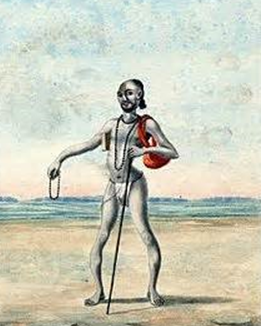Talk:Sanātana Hindu Dharm and its Ṛṣis and Ṛṣikās:Ṛṣi Aṣṭāvakra
By Vishal Agarwal
Story of Ṛṣi Kahor and the Birth of Aṣṭāvakra
Ṛṣi Kahor was a famous scholar of the Veda-s. One day, he was chanting the Veda-s in the presence of his pregnant wife Sujātā. Suddenly, the fetus spoke from inside his mother’s womb and said that his father was not chanting the Veda-s correctly.
Kahor’s ego was hurt, and he cursed his own son. He said, since the unborn child had dared to correct him, he would be born with eight bends in his body.
Before the baby was born, Kahor heard that King Janaka had organized a grand yajña for which he was looking for suitable priests. Kahor reached the palace of Janaka and offered to help. But the king placed a precondition before hiring Kahor's services: only a priest who was a greater scholar than his court scholar Vandi would be accepted. If Kahor could defeat Vandi in a scholarly debate on the Veda-s, he would be hired. If he was defeated, he would have to drown himself to death.
Kahor, confident of his knowledge, accepted the challenge. Unfortunately, he lost and had to drown himself as promised.
Sometime later, Sujātā gave birth to a baby. Due to his father’s curse, the baby had eight bends in his body. Therefore, he was named Aṣṭāvakra, meaning ‘one with eight bends’. Despite his physical deformity and ugliness, Aṣṭāvakra became a great scholar of Śāstras even as a child.
When he was twelve years of age, his uncle told him how his father Kahor had died after losing the debate with Vandi.
Aṣṭāvakra’s Arrival at Janaka’s Court
Aṣṭāvakra decided to avenge his father’s death. He travelled to the court of Janaka after impressing the palace guards with his knowledge.
When he entered the court, the courtiers and scholars present there began laughing at his deformed appearance.
Once their laughter subsided, Aṣṭāvakra addressed them with calm dignity. He said that he had come to meet scholars, but it appeared that the assembly of King Janaka was not composed of scholars but of cobblers.
The king and his court were stunned at Aṣṭāvakra’s bold words. But the child continued, explaining that a true scholar is one who looks beyond the body, which is nothing but a bag of leather the skin enclosing bones, blood, and other matter within it.
The scholar understands that this bag of leather is temporary and perishable. Only the ātmā within is real and survives death. But these so-called scholars had looked only at his body and laughed. They had no awareness of the ātmā that gives his body life.
King Janaka was very impressed by the wisdom of Aṣṭāvakra. But the boy then asked to debate with Vandi, with the same wager - if Vandi lost, he would drown himself to death. If Aṣṭāvakra lost, he would do the same. The debate resulted in Vandi's defeat. But he would not drown himself, and instead said, I am a messenger of Varuṇa, the devatā of water. I cannot be drowned. Your father was not the only scholar who drowned himself to death.There were many others who lost the debate with me and suffered the same fate. And the truth behind this is that these scholars are not dead. They were needed by my father for the performance of a yajña. There were therefore immediately taken to the realm of Varuṇa after they drowned. Now, that the yajña is completed, and they can all return.
As Vandi said these words, all the ṛṣi-s appeared from the water and walked on the riverbank. Among them was Kahor, the father of Aṣṭāvakra. Kahor blessed his son for his devotion and asked him to take a dip in the river. When Aṣṭāvakra emerged from the water, his bends in the body had all disappeared and he had a normal physique like everyone else.
From this story, we learn that we should not judge a person based on his appearance. After all, the body is really like a leather bag inside which are contained bones, muscles, blood, and other organs. A wise person knows that it is not the body, but the mind and the ātmā inside the body that are important. A person becomes great or low not by how his body looks like, but whether his mind and ātmā are pure or not.
The teachings of Aṣṭāvakra given in the court of King Janaka are collected in a scripture called the Aṣṭāvakra Saṁhitā. The story is contained in the Mahābhārata and in other scriptures.


